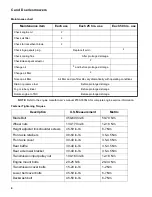
C and D series mowers
2
Safety
This Service Manual is meant to be used along with the Operator’s Manual. Read the Operator’s Manual and
familiarize yourself with the safety and operational instructions for the equipment being worked on. Keep a copy of
the Operator’s Manual for quick reference. Operator’s manuals may be viewed for free at the brand support website.
It will be necessary to have the complete model and serial number for the equipment.
•
Be prepared in case of emergency:
Keep a fire extinguisher nearby
Keep a first aid kit nearby
Keep emergency contact numbers handy
•
Replace any missing or damaged safety labels on shop equipment.
•
Replace any missing or damaged safety labels on equipment being serviced.
•
Grooming and attire:
Do not wear loose fitting clothing that may become entangled in equipment.
Long hair should be secured to prevent entanglement in equipment.
Jewelry is best removed.
•
Protective gear: includes, but is not limited to
Clear eye protection while working around any machinery
Protective gloves where necessary
Armored footwear when working around any machinery
Hearing protection when working in noisy environments
Chemically resistant gloves when working with chemicals or solvents
Respirator when working with chemical or solvents
Appropriate tinted eye protection when cutting or welding
! WARNING
! WARNING
! CAUTION
! CAUTION
•
Remember that some hazards have a cumulative effect. A single exposure may
cause little or no harm, but continual or repeated exposure may cause very seri-
ous harm.
•
Clean spills and fix obviously dangerous conditions as soon as they are noticed.
•
Lift and support heavy objects safely and securely.
•
Be aware of your surroundings and potential hazards that are inherent to all
power equipment. All the labels in the world cannot protect a technician from an
instant of carelessness.
Exhaust fumes from running engines contain carbon monoxide (CO). Carbon monox-
ide is a colorless odorless gas that is fatal if inhaled in sufficient quantity. Only run engines
in well ventilated areas. If running engines indoors, use an exhaust evacuation system with
adequate make-up air ventilated into the shop.
! DANGER
! DANGER
! CAUTION
! CAUTION







































